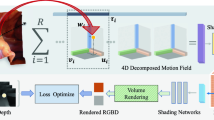Abstract
Purpose
Complications related to vascular damage such as intra-operative bleeding may be avoided during neurosurgical procedures such as petroclival meningioma surgery. To address this and improve the patient’s safety, we designed a real-time blood vessel avoidance strategy that enables operation on deformable tissue during petroclival meningioma surgery using Micron, a handheld surgical robotic tool.
Methods
We integrated real-time intra-operative blood vessel segmentation of brain vasculature using deep learning, with a 3D reconstruction algorithm to obtain the vessel point cloud in real time. We then implemented a virtual-fixture-based strategy that prevented Micron’s tooltip from entering a forbidden region around the vessel, thus avoiding damage to it.
Results
We achieved a median Dice similarity coefficient of 0.97, 0.86, 0.87 and 0.77 on datasets of phantom blood vessels, petrosal vein, internal carotid artery and superficial vessels, respectively. We conducted trials with deformable clay vessel phantoms, keeping the forbidden region 400 \(\mu \)m outside and 400 \(\mu \)m inside the vessel. Micron’s tip entered the forbidden region with a median penetration of just 8.84 \(\mu \)m and 9.63 \(\mu \)m, compared to 148.74 \(\mu \)m and 117.17 \(\mu \)m without our strategy, for the former and latter trials, respectively.
Conclusion
Real-time control of Micron was achieved at 33.3 fps. We achieved improvements in real-time segmentation of brain vasculature from intra-operative images and showed that our approach works even on non-stationary vessel phantoms. The results suggest that by enabling precise, real-time control, we are one step closer to using Micron in real neurosurgical procedures.










Similar content being viewed by others
Availability of data and material
Data are available at https://drive.google.com/drive/folders/1zEoZAq3yviJ6XRumxCUr-RX4bNZz89Zq?usp=sharing.
Code Availability Statement
Code is available at https://github.com/aravindvenu7/MicronProject.
References
Al-Mefty O, Fox JL Sr, Smith RR (1988) Petrosal approach for petroclival meningiomas. Neurosurgery 22(3):510–517
Attia M, Hossny M, Nahavandi S, Asadi H (2017) Surgical tool segmentation using a hybrid deep cnn-rnn auto encoder-decoder. In: 2017 IEEE international conference on systems, man, and cybernetics (SMC). IEEE, pp 3373–3378
Ghosh T, Li L, Chakareski J (2018) Effective deep learning for semantic segmentation based bleeding zone detection in capsule endoscopy images. In: 2018 25th IEEE international conference on image processing (ICIP). IEEE, pp 3034–3038
Gonenc B, Balicki MA, Gehlbach P, Riviere CN, Taylor RH, Iordachita I (2012) Preliminary evaluation of a micro-force sensing handheld robot for vitreoretinal surgery. In: 2012 IEEE/RSJ international conference on intelligent robots and systems. IEEE, pp 4125–4130
Kingma DP, Ba J (2015) Adam: a method for stochastic optimization. In: Bengio Y, LeCun Y (eds) 3rd international conference on learning representations, ICLR 2015, San Diego, CA, USA, May 7–9, 2015. Conference Track Proceedings (2015)
Lang J (2012) Clinical anatomy of the head: neurocranium\(\cdot \) Orbit\(\cdot \) Craniocervical Regions. Springer Science & Business Media
MacLachlan RA, Becker BC, Tabarés JC, Podnar GW, Lobes LA Jr, Riviere CN (2011) Micron: an actively stabilized handheld tool for microsurgery. IEEE Trans Robotics 28(1):195–212
MacLachlan RA, Riviere CN (2008) High-speed microscale optical tracking using digital frequency-domain multiplexing. IEEE Trans Instrum Measur 58(6):1991–2001
Moccia S, Foti S, Routray A, Prudente F, Perin A, Sekula R, Mattos L, Balzer J, Fellows-Mayle W, De EM, Riviere C (2018) Toward improving safety in neurosurgery with an active handheld instrument. Ann Biomed Eng 46(10):1450–1464
Moccia S, Romeo L, Migliorelli L, Frontoni E, Zingaretti P (2020) Supervised cnn strategies for optical image segmentation and classification in interventional medicine. In: Deep learners and deep learner descriptors for medical applications. Springer, pp 213–236
Niu PP, Yu Y, Zhou HW, Liu Y, Luo Y, Guo ZN, Jin H, Yang Y (2016) Vessel wall differences between middle cerebral artery and basilar artery plaque s on magnetic resonance imaging. Sci Rep 6(1):1–7
Poudel RP, Bonde U, Liwicki S, Zach C (2018) Contextnet: exploring context and detail for semantic segmentation in real-time. In: 29th British machine vision conference
Poudel RP, Liwicki S, Cipolla R (2019) Fast-scnn: fast semantic segmentation network. In: 30th British machine vision conference
Ronneberger O, Fischer P, Brox T (2015) U-net: convolutional networks for biomedical image segmentation. In: International conference on medical image computing and computer-assisted intervention. Springer, pp 234–241
Sabaté S, Mases A, Guilera N, Canet J, Castillo J, Orrego C, Sabaté A, Fita G, Parramón F, Paniagua P, Rodriguez A (2011) Incidence and predictors of major perioperative adverse cardiac and cerebrovascular events in non-cardiac surgery. Br J Anaes 107(6):879–890
Zhao H, Qi X, Shen X, Shi J, Jia J (2018) Icnet for real-time semantic segmentation on high-resolution images. In: Proceedings of the European conference on computer vision (ECCV), pp 405–420
Funding
This work was partially funded by the US National Institutes of Health (grant nos. R01EB000526 and R01EB024564).
Author information
Authors and Affiliations
Corresponding author
Ethics declarations
Conflict of interest
The authors declare that they have no conflicts of interest.
Ethics approval
The collection of data was in accordance with the 1964 Declaration of Helsinki, revised in 2000.
Consent for publication
Written consent was obtained from all authors included in the study.
Additional information
Publisher's Note
Springer Nature remains neutral with regard to jurisdictional claims in published maps and institutional affiliations.
Rights and permissions
About this article
Cite this article
Venugopal, A., Moccia, S., Foti, S. et al. Real-time vessel segmentation and reconstruction for virtual fixtures for an active handheld microneurosurgical instrument. Int J CARS 17, 1069–1077 (2022). https://doi.org/10.1007/s11548-022-02584-5
Received:
Accepted:
Published:
Issue Date:
DOI: https://doi.org/10.1007/s11548-022-02584-5




